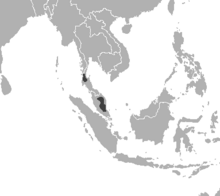Malayan tiger: Difference between revisions
BhagyaMani (talk | contribs) →Diet and biology: changed title |
BhagyaMani (talk | contribs) →Distribution and habitat: extended with ref |
||
| Line 34: | Line 34: | ||
== Distribution and habitat == |
== Distribution and habitat == |
||
The geographic division between Malayan and Indochinese tigers is unclear as tiger populations in northern Malaysia are contiguous with those in southern [[Thailand]].<ref name=iucn/> |
|||
Between 1991 and 2003, tiger signs were reported from early-succession vegetation fields, agricultural areas outside forests in [[Kelantan]], [[Terengganu]], [[Pahang]], and [[Johor]], and many riparian habitats outside forests in Pahang, [[Perak]], Kelantan, Terengganu, and Johor. Most of the major rivers that drain into the [[South China Sea]] had some evidence of tigers, whereas those draining into the [[Straits of Melaka]] in the west did not. Tiger sign was not reported from [[Perlis]], [[Pulau Pinang]], and [[Malacca]], and the federal territories of [[Kuala Lumpur]] and [[Putrajaya]] in the west coast. The total potential tiger habitat was {{convert|66211|km2|sqmi|abbr=on}}, which comprised {{convert|37674|km2|sqmi|abbr=on}} of confirmed tiger habitat, {{convert|11655|km2|sqmi|abbr=on}} of expected tiger habitat and {{convert|16882|km2|sqmi|abbr=on}} of possible tiger habitat. All the protected areas greater than {{convert|402|km2|sqmi|abbr=on}} in size had tigers.<ref>Kawanishi, K., Yatim, S. H., Abu Hashim, A. K., Topani, R. (2003) [http://www.nfwf.org/AM/Template.cfm?Section=Home&TEMPLATE=/CM/ContentDisplay.cfm&CONTENTID=8055 ''Distribution and potential population size of the tiger in Peninsular Malaysia'']. Journal of Wildlife Parks (Malaysia) 21: 29–50.</ref> |
Between 1991 and 2003, tiger signs were reported from early-succession vegetation fields, agricultural areas outside forests in [[Kelantan]], [[Terengganu]], [[Pahang]], and [[Johor]], and many riparian habitats outside forests in Pahang, [[Perak]], Kelantan, Terengganu, and Johor. Most of the major rivers that drain into the [[South China Sea]] had some evidence of tigers, whereas those draining into the [[Straits of Melaka]] in the west did not. Tiger sign was not reported from [[Perlis]], [[Pulau Pinang]], and [[Malacca]], and the federal territories of [[Kuala Lumpur]] and [[Putrajaya]] in the west coast. The total potential tiger habitat was {{convert|66211|km2|sqmi|abbr=on}}, which comprised {{convert|37674|km2|sqmi|abbr=on}} of confirmed tiger habitat, {{convert|11655|km2|sqmi|abbr=on}} of expected tiger habitat and {{convert|16882|km2|sqmi|abbr=on}} of possible tiger habitat. All the protected areas greater than {{convert|402|km2|sqmi|abbr=on}} in size had tigers.<ref>Kawanishi, K., Yatim, S. H., Abu Hashim, A. K., Topani, R. (2003) [http://www.nfwf.org/AM/Template.cfm?Section=Home&TEMPLATE=/CM/ContentDisplay.cfm&CONTENTID=8055 ''Distribution and potential population size of the tiger in Peninsular Malaysia'']. Journal of Wildlife Parks (Malaysia) 21: 29–50.</ref> |
||
Revision as of 17:57, 15 November 2011
| Malayan Tiger | |
|---|---|

| |
| Scientific classification | |
| Kingdom: | |
| Phylum: | |
| Class: | |
| Order: | |
| Family: | |
| Genus: | |
| Species: | |
| Subspecies: | P. t. jacksoni
|
| Trinomial name | |
| Panthera tigris jacksoni Luo et al., 2004
| |

| |
| Range map | |
The Malayan tiger (Panthera tigris jacksoni) is a tiger subspecies that inhabits the southern and central parts of the Malay Peninsula and has been classified as endangered by IUCN in 2008 as the population was estimated at 493 to 1,480 adult individuals in 2003; none of the three subpopulations likely harbors more than 250 mature breeding individuals, with a declining trend.[1]
In 2004, Panthera tigris jacksoni was recognized as a new subspecies when a genetic analysis found that they are distinct in mtDNA and micro-satellite sequences from Panthera tigris corbetti.[2]
The Malayan tiger's local name is harimau belang.
Characteristics
There is no clear difference between the Malayan and the Indochinese tiger when specimens from the two regions are compared cranially or in pelage. No type specimen was designated.[3]
Its size is closer to the Sumatran tiger, with an average weight of 120 kilograms (260 lb) for adult males and 100 kg (220 lb) for females.[4] Male measure around 237 centimetres (93 in) in length from head to tail and females around 200 cm (79 in) in length.
Distribution and habitat
The geographic division between Malayan and Indochinese tigers is unclear as tiger populations in northern Malaysia are contiguous with those in southern Thailand.[1]
Between 1991 and 2003, tiger signs were reported from early-succession vegetation fields, agricultural areas outside forests in Kelantan, Terengganu, Pahang, and Johor, and many riparian habitats outside forests in Pahang, Perak, Kelantan, Terengganu, and Johor. Most of the major rivers that drain into the South China Sea had some evidence of tigers, whereas those draining into the Straits of Melaka in the west did not. Tiger sign was not reported from Perlis, Pulau Pinang, and Malacca, and the federal territories of Kuala Lumpur and Putrajaya in the west coast. The total potential tiger habitat was 66,211 km2 (25,564 sq mi), which comprised 37,674 km2 (14,546 sq mi) of confirmed tiger habitat, 11,655 km2 (4,500 sq mi) of expected tiger habitat and 16,882 km2 (6,518 sq mi) of possible tiger habitat. All the protected areas greater than 402 km2 (155 sq mi) in size had tigers.[5]
Ecology and behavior
Malayan tigers prey on sambar deer, barking deer, wild boar, bearded pigs and serow. Tigers in Taman Negara also prey on sun bear and elephant calves. Whether their principal prey includes adult gaur and tapir is unknown. Occasionally, livestock is also taken; however, tiger predation reduces the numbers of wild boar which can become a serious pest in plantations and other croplands. Studies indicate that in areas where large predators (tigers and leopards) are extinct, wild pigs are over 10 times more numerous than in areas where tigers are still present.[6][7][8]
Tigers occur at very low densities 1.1–1.98 tigers per 100 km² in the rainforest as a result of low prey densities, thus in order to maintain viable tiger populations of minimum of 6 breeding females, reserves need to be larger than 1000 km². Biological/ecological research on the Malayan tiger is still in infancy. For example, information on dietary preference, morphological measurements, demographic parameters, social structure, communication, home range sizes, dispersal capabilities are all lacking.[9]
Captive
A genetic analysis of the phylogeny of tigers in 2004 split the Indochinese subspecies into two distinct subspecies: the Indochinese tiger and the Malayan tiger and the authors argue that the captive populations for these two subspecies should be managed in a similar way to the other recognized subspecies but it is unclear how this information will be used by the zoo community.
Naming controversy
When the Malayan tiger was accepted as a subspecies of the tiger family, the news was warmly received in Malaysia. However, there was soon debate over the scientific naming of the Malayan tiger. The formal description of the subspecies gave it the name Panthera tigris jacksoni in honour of tiger specialist Peter Jackson.[10]
However, the Malaysian Association of Zoological Parks and Aquaria (MAZPA) and the Government of Malaysia protested, arguing that Malaysia should have been consulted over the naming of its national icon.[11] Malaysia holds that the naming should reflect the geographical region, Malaysia. In Malaysia, therefore, the Malayan tiger is known as Panthera tigris malayensis.[citation needed]
In culture
The Malayan tiger is depicted in the coat of arms of Malaysia, symbolizing the government, and appears in various heraldry of Malaysian institutions such as Royal Malaysian Police, Maybank, Proton and Football Association of Malaysia. It symbolizes bravery and strength to Malaysians. It is also the nickname for the Malaysian national football team. The tiger has been given various nicknames by Malaysians, notably "Pak Belang," which literally means "Uncle Stripes." Pak Belang features prominently in folklore as one of the adversaries of Sang Kancil (the mouse deer).
The Malayan tiger was featured on Special Service Group insignia.
References
- ^ a b c Template:IUCN
- ^ Luo, S. J., Kim, J. H., Johnson, W. E., Van Der Walt, J., Martenson, J., Yuhki, N., Miquelle, D. G., Uphyrkina, O., Goodrich, J. M., Quigley, H., Tilson, R., Brady, G., Martelli, P., Subramaniam, V., Mcdougal, C., Hean, S., Huang, S. Q., Pan, W., Karanth, U. K., Sunquist, M., Smith, J. L. D., O'Brien, S. J. (2004) Phylogeography and genetic ancestry of tigers (Panthera tigris). PLoS Biology 2: 2275–2293.
- ^ Mazák, J. H., Groves, C. P. (2006) A taxonomic revision of the tigers (Panthera tigris). Mammalian Biology 71 (5): 268–287.
- ^ WWF - Malayan tiger
- ^ Kawanishi, K., Yatim, S. H., Abu Hashim, A. K., Topani, R. (2003) Distribution and potential population size of the tiger in Peninsular Malaysia. Journal of Wildlife Parks (Malaysia) 21: 29–50.
- ^ Yong, D. L. (2010). "The status on Singapore island of the Eurasian wild pig Sus scrofa (Mammalia: Suidae)" (PDF). Nature in Singapore. 3: 227–237.
{{cite journal}}: Unknown parameter|coauthors=ignored (|author=suggested) (help) - ^ Ickes, Kalan; Paciorek, Christopher J.; Thomas, Sean C. (2005). "Impacts of nest construction by native pigs (Sus scrofa) on lowland Malaysian rain forest saplings" (PDF). Ecology. 86 (6): 1540–1547. JSTOR 3450779.
- ^ Ickes, Kalan (2001). "Hyper-abundance of native wild pigs (Sus scrofa) in a lowland dipterocarp rain forest of Peninsular Malaysia". Biotropica. 33: 682–690. JSTOR 3593170.
- ^ Save The Tiger Fund: Malayan Tiger
- ^ "IUCN tiger specialist Peter Jackson earns his stripes". International Union for Conservation of Nature. June 7, 2005. Retrieved July 19, 2011.
- ^ "Malayan tiger may get new name". NST. November 4, 2004.
- General references
- Luo, Shu-Jin (2004). "Phylogeography and genetic ancestry of tigers (Panthera tigris)". PLoS Biology. 2 (12): e442. doi:10.1371/journal.pbio.0020442. PMC 534810. PMID 15583716.
{{cite journal}}: Unknown parameter|coauthors=ignored (|author=suggested) (help)CS1 maint: unflagged free DOI (link)

